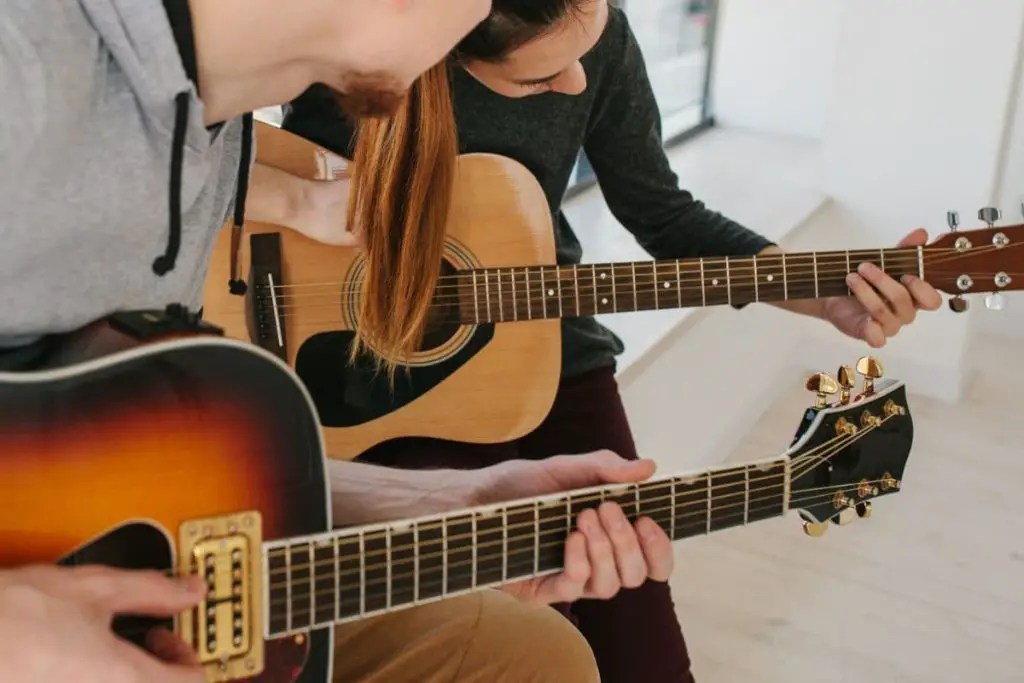When we think about guitar solos, we mostly think about playing ear-melting, shrieking solos on an electric guitar. Acoustic guitar solos are not that common and are definitely not the prototypical kind of guitar solo. However, soloing on an acoustic guitar is possible, and it can sound amazing with a little bit of effort.
If you want to solo with an acoustic guitar, you have to learn at least the basic scales. Once you’re familiar with them, experiment and try different things until you get something you like. Start small and add details later. Use chords and try different techniques.
If you’re interested in learning how to solo with an acoustic guitar, you’ve come to the right place. This article will give you a detailed overview of the things you should do if you want to create great acoustic solos, so you’ll be shredding away in no time.
If you want to find out what my recommended guitar gear is, then here is what I recommend on Amazon:
- Fender Cutaway Acoustic-Electric Guitar Bundle (MY FAVORITE GUITAR)
- Snark SN-8 Super Tight All Instrument Tuner (Easiest Tuner I’ve Used)
- 6 String Acoustic Guitar Capo (Best CAPO for quick changes)
- Dunlop Max Grip 1.0mm Nylon Picks (Thick Guitar Pick So You Don’t Lose Grip!)
- Universal Guitar Stand (Cheap & Minimalist Guitar Stand I Recommend)
- Levy’s 2″ Wide Quick Adjust Guitar Strap (Best Guitar Strap For Any Level)

1. Learn the Basic Scales
Learning and practicing scales might be the least pleasurable part of learning guitar. Some might enjoy torturing themselves with this, but most of us just want to jam and have fun as soon as we pick up a guitar.
However, it’s impossible to jam out and have fun if you don’t have a great grasp of the foundations of guitar playing. If you just pick up a guitar and start playing whatever, you’re not very likely to produce anything meaningful unless you have some kind of sixth sense for music.
Therefore, you have to learn some scales if you want to write coherent solos. This isn’t only true for acoustic guitar but for any instrument on which you can solo. Once you’ve memorized the necessary scales and playing them has become second nature, you can start soloing.
Does that mean you have to learn every scale there is? Of course not. There are tons of scales, and it’s questionable if one person can even memorize all of them perfectly. There is a lot of overlap, which makes things easier, but it’s still unnecessary to put that much pressure.
Learning the most basic scales is more than enough for most people. It’s enough for beginners, without a doubt, so you can get a good start with just a few basic scales. Once you feel like you’ve done everything you could with them, you can start learning new, more complex scales and improving your knowledge.
As a beginner, you can start with pentatonic scales. If a scale is pentatonic, it means that it consists of five notes, which makes them easy to memorize and work with. For example, in the A minor scale, you’ve only got A, B, D, E, and G. Simple, memorable, and effective.
While having only five notes to work with may seem extremely limited, it’s more than enough for a start. Many well-known riffs consist of only three or four notes, which shows that you can get a lot done with very little if you apply yourself. Lots of pros rely on pentatonic scales and manage to create decent solos.
Using a limited scale will also force you to be more creative. Necessity usually breeds innovation, which is most certainly true when it comes to playing guitar. Having fewer notes at your disposal will make you play around with them more, and you might create something catchy and unique.
Besides, using more notes doesn’t mean you’ll write better solos. You might be tempted to go mad with the scales and end up creating something that is technically complex but will move no one except a few guitar nerds.

Remember, you’re trying to express yourself while entertaining your audience and making them vibe to your music. If you set that as your goal, you’ll realize that complexity is not necessarily better.
2. Create a Background for Your Solo
Every solo needs some kind of rhythmic background. You can’t just solo in silence, or else it will sound very thin, you might easily lose the rhythm, and it most likely won’t sound good without accompaniment.
The background doesn’t have to be super complicated. You can pick a scale and use three or four chords in that scale to create a simple but catchy rhythmic background over which you can lay down your solo.
Apart from giving you a canvas for your solo, it will also give you a rough idea of what to play. Having your solo revolve around certain chords puts it in context and makes it a part of a coherent musical whole. You can’t have a solo just hanging in thin air.
When you create your chord progression, you can record it. You can use a looper pedal, or if you have a microphone, you can record the progression to your computer and reproduce it that way. You can record on your mobile phone if neither option is available, although it probably won’t be as good.
If you have the time, skills, and resources, you should also program a simple drum beat to accompany your chord progression. When you mix it with the chord progression, you’ll have a more complete backing for your creative endeavors, and you will be able to focus much more on the solo.
When your backing track is ready, you can move on to creating the actual solo.
3. Start Small
When first starting out, you probably won’t be able to improvise an entire solo from start to finish and make it sound good. In fact, even seasoned guitarists take time to think out and write down their guitar solos before including them in their songs.
Instead of trying to nail everything in one try, you should start slowly and add details as you go along. Listen to your backing track a few times and try to think of some things you can play over it. Hum or whistle your ideas to see if the melody fits the rhythm.
At first, you should focus on short phrases and motifs. Focus on a few notes and the first two or three strings. Limiting your scope will make it easier to focus and think of a catchy hook or motif you can repeat throughout your songs.
Play different notes together until you think of something that sounds good. After that, try to make that combination of notes as catchy and groovy as possible. Try to think of as many different ways in which you can play it and experiment to see which one you like most.
Also, try adding some twists to the note progression. Don’t simply move from one note to the other. Use slides or hammer-ons. Bend the strings and see how far you can go without being out of key. Add some vibrato here and there and see how the melody works with that.
Simply said, you should play around as much as possible until you get something you really like. Once you create one catchy phrase, you can create another one that’s either a variation of the first one or a progression into something completely different.
Think of the ways you can connect the two phrases into a coherent whole. Don’t be afraid to repeat something if you’ve thought of a cool motif. Motifs are necessary to show that the solo is a coherent whole revolving around an idea and not just a mish-mash of unrelated hooks.
Resist the temptation to channel your inner guitar god and blow everyone away with the sheer complexity of your solo. You’ll likely end up with a riff salad that won’t excite anyone. Sure, you might have fun playing it, but if your goal is to be a live musician one day, you should not get used to doing things like this.

4. Use Chord Fragments
Using chord fragments is a technique that is particularly useful when soloing on an acoustic guitar. When playing an electric, you can rely solely on single-note passages, as you can count on the amplifier and effect pedals to make the sound louder and thicker.
You don’t have the same options when playing an acoustic guitar, and your solo might sound somewhat thin if you only play single notes, especially when playing the higher notes. Chord fragments can help you with that, as they naturally sound thicker than single notes.
Plus, chord fragments will add some texture to your solo. It will also add some variety, so it will be a nice addition and a great way to make it sound more expressive, original, and groovy. Of course, overdoing this will achieve the opposite effect, but when added tastefully, it can really make your solo stand out.
Chord fragments, as the name suggests, are parts of chords played instead of whole chords. For example, you can play the third and seventh notes from a chord instead of all the notes. This will add some punch to your solo without overpowering the rhythm section and turning everything into an incoherent mess.
Avoid using full chords and barre chords. Playing them in the middle of your solo will most likely seem clunky at best and, at worst, may completely throw you off course and ruin the solo. Besides, if there is a rhythm guitar, it’s already playing the chords, so there’s no need to play the same thing twice at the same time.
5. Use Arpeggios
Arpeggios are another cool way to spice up your guitar solos and add another tool to your solo toolbox. They are great for improvisations, but you can also include them in a solo that you took time to write and think through.
Arpeggios are also known as broken chords. This means that you don’t play the notes of a chord simultaneously; instead, you play them individually. You can do this in ascending, descending, or random order, which allows you to be super creative and easily craft catchy guitar solos.
You can play arpeggios using different picking styles. You can pull-off, hammer-on, slide, or do anything you otherwise would. If you’re feeling extra spicy, you can even forgo your guitar pick and pick the strings with your fingers. This can be extremely effective and can make your solo really come alive.
Theoretically, you could base your entire solo on arpeggios, but that might be overkill. You should base your solo on the scale and add arpeggios to spice things up here and there. They sound great when played over their matching chords.
However, you don’t have to play arpeggios in the exact same position where the rhythm guitar plays the chord. It’s even better to move up or down the neck and play in a different position. This will let your arpeggios stand out and be heard more easily. Plus, the solo and rhythm guitar will complement each other, which always sounds much better than when they play the same thing.

6. Use Banjo Rolls
Banjo rolls are another technique that’s often used to liven up a guitar solo, and they sound particularly good on acoustic guitars. If you’re not a fan of banjos, don’t worry; this technique won’t make your guitar sound like a banjo. It just resembles the typical way of playing a banjo.
This technique is basically a rotating/alternating picking pattern that uses your thumb, index, and middle fingers. You can do this by going from thicker to thinner strings or the other way around, picking one note at a time with your fingers.
This technique is easiest to use with open strings, so it works well with scales that include a lot of these, such as the key of Em. Keys that don’t have a lot of open strings won’t work well with this technique, so it’s not a very versatile tool, but it can be effective when deployed at the right moment.
7. Don’t Overthink Your Guitar Solos
While there is a certain amount of information to remember and think about when it comes to soloing on your acoustic guitar, you shouldn’t get anxious. As long as you have a good grasp of the basics, there is no need to think too much about every single detail of your guitar solo.
Remember that your music should be a way to express yourself, and the solo is one of the most expressive parts of every song. If you want to be a stage musician, you’ll also have to connect to your audience, entertain them, and make them feel what you feel.
If you turn your solo writing into a purely intellectual affair, you’ll take away a big part of the emotional expressiveness of your solo. You shouldn’t approach it as an equation and obsess over every tone you play. Infusing the solo with a little bit of your soul goes a longer way than creating a technically perfect solo that feels robotic and lacks emotion.
Of course, it’s important to be in key, but even if you accidentally play a wrong note, it won’t be that noticeable if you play with passion and if your audience is having fun. Playing all the right notes mechanically is a much bigger music sin.
There is also no need to spread out a music sheet in front of you and think super deeply about how to put the notes together. Of course, you should write down your solos when you’re happy with them, but it’s much better to try things out and see what works. That’s how you’ll learn to be adaptable and play with feeling.
The bottom line is: don’t forget to have fun while playing music. It should not be a chore and a cause for frustration. Relax, trust the process, and never stop trying out new things.
8. Play With Other People
When you get comfortable with some elementary soloing skills, you should start meeting up with other musicians to jam together. Finding an entire band would be perfect, but even if you can just find another guitarist, it will help you expand your music skills.

Jamming with other musicians will be a great thing for your improvisation skills. You’ll have to think fast and be able to create at least somewhat decent solos as everyone else is playing. This might be challenging at first, but it’s quite fun, and if you do it regularly, you’re bound to get better.
This will also make you a good team player. You’ll get a feeling for what the rest of the band is doing, and you’ll learn how to adapt to the changes they make to the music. Learning how to play with people instead of a backing track is a crucial component of your music journey, as it’s much more unpredictable and will teach you real-life music skills.
When you play with people, you can also get ideas from the other band members, and you can get help if you get stuck. It’s also possible to get quick lessons on music theory, which will add to the pace at which you progress as a musician.
Final Thoughts
Remember to grasp the basics of music before you start soloing, and never forget to have fun. Experiment to see what works, and always play from the heart. Good luck with your acoustic solos!
If you want to find out what my recommended guitar gear is, then here is what I recommend on Amazon:
- Fender Cutaway Acoustic-Electric Guitar Bundle (MY FAVORITE GUITAR)
- Snark SN-8 Super Tight All Instrument Tuner (Easiest Tuner I’ve Used)
- 6 String Acoustic Guitar Capo (Best CAPO for quick changes)
- Dunlop Max Grip 1.0mm Nylon Picks (Thick Guitar Pick So You Don’t Lose Grip!)
- Universal Guitar Stand (Cheap & Minimalist Guitar Stand I Recommend)
- Levy’s 2″ Wide Quick Adjust Guitar Strap (Best Guitar Strap For Any Level)
Related Posts:
- Why Do Guitar Strings Have Different Thicknesses?
- How To Stop Guitar Strings from Breaking While Tuning
- 9 Ways to Make an Acoustic Guitar Quieter
- 20 Ways To Know if Your Guitar Is Acoustic or Classical
- 7 Steps to Making Your Acoustic Guitar Electric
- How To Play Guitar Without Looking (9 Training Methods)
- How To Keep a Guitar Strap From Falling Off (8 Ways)
- How To Fix a Loose or Broken Guitar Input Jack
- 11 Finger Stretching Exercises To Do Without a Guitar
- How To Play Bar Chords On Acoustic Guitar (Easy Beginner Tutorial)
- Acoustic Guitar Anatomy
- What Is Shredding On Guitar? And How To Shred On Guitar
- 27 Guitar Riffs To Learn for Beginners That Sound Awesome! (Easy, Fun To Play)
- Best Acoustic Guitars
- Best Acoustic Guitars Under $500

